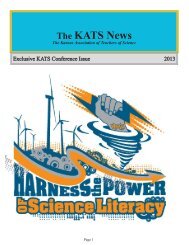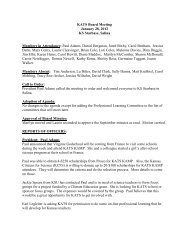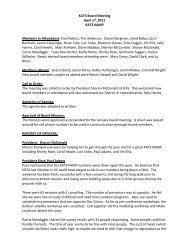Create successful ePaper yourself
Turn your PDF publications into a flip-book with our unique Google optimized e-Paper software.
Balanced<br />
Force<br />
Unbalanced<br />
Force<br />
the forces are balanced. If the ball is moving<br />
at a constant speed and in a straight line, the<br />
forces are balanced. If the ball is accelerating<br />
or changing its direction, the forces are<br />
unbalanced.<br />
Mass is the amount of matter contained in<br />
an object. The object does not have to be<br />
solid. It could be the amount of air contained<br />
in a balloon or the amount of water in a<br />
glass. The important thing about mass is that<br />
unless you alter it in some way, it remains the<br />
same whether the object is on Earth, in Earth<br />
orbit, or on the Moon. Mass just refers to the<br />
quantity of matter contained in the object.<br />
(Mass and weight are often confused. They are<br />
not the same thing. Weight is a force and is<br />
the product of mass times the acceleration of<br />
gravity.)<br />
Acceleration relates to motion. It means<br />
a change in motion. Usually, change refers<br />
to increasing speed, like what occurs when<br />
you step on the accelerator pedal of a car.<br />
Acceleration also means changing direction.<br />
Top view of two riders on a carousel. The carousel<br />
platform exerts unbalanced forces on the riders,<br />
preventing them from going in straight lines.<br />
Instead, the platform continually accelerates the<br />
riders in a counterclockwise direction.<br />
This is what happens on a carousel. Even<br />
though the carousel is turning at a constant<br />
rate, the continual change in direction of<br />
the horses and riders (circular motion) is an<br />
acceleration.<br />
Action is the result of a force. A cannon fires,<br />
and the cannon ball flies through the air. The<br />
movement of the cannon ball is an action.<br />
Release air from an inflated balloon. The air<br />
shoots out the nozzle. That is also an action.<br />
Step off a boat onto a pier. That, too, is an<br />
action.<br />
Reaction is related to action. When the<br />
cannon fires, and the cannon ball flies through<br />
the air, the cannon itself recoils backward.<br />
That is a reaction. When the air rushes out of<br />
the balloon, the balloon shoots the other way,<br />
another reaction. Stepping off a boat onto to<br />
a pier causes a reaction. Unless the boat is<br />
held in some way, it moves in the opposite<br />
direction. (Note: The boat example is a great<br />
demonstration of the action/reaction principle,<br />
providing you are not the one stepping off the<br />
boat!)<br />
Newton’s First Law<br />
This law is sometimes referred to as Galileo’s<br />
law of inertia because Galileo discovered the<br />
principle of inertia. This law simply points<br />
21










